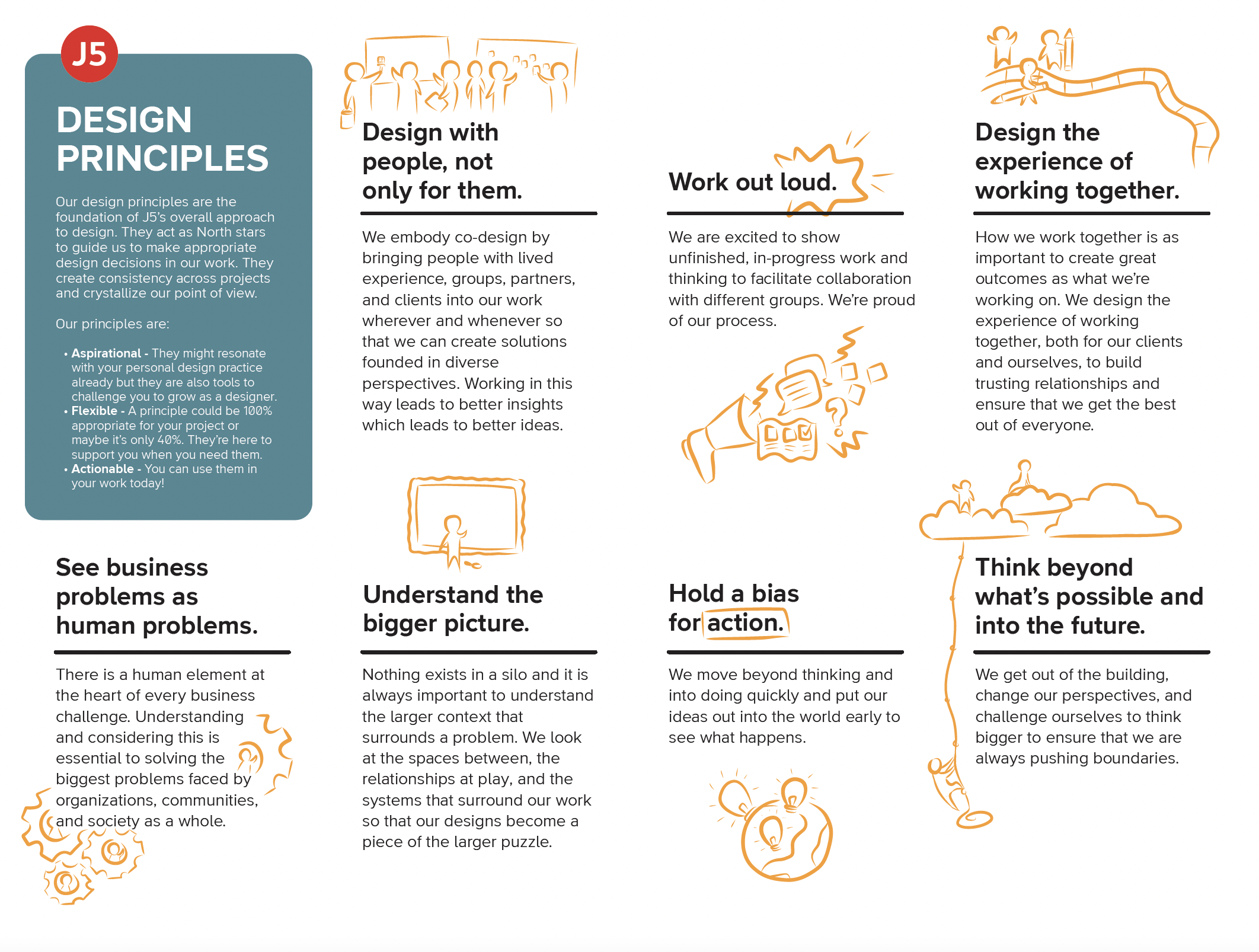How We Created Our J5 Design Principles
What Are Principles and Why Do We Need Them?
At J5, we created co-created our design principles as a team and this article outlines how we went about that process (in the spirit of working out loud!). But first you might wonder, what are design principles?
Simply put, design principles are a set of considerations that form the basis for how a design team makes decisions. These decisions can be as granular as a digital interaction or a wide as a company strategy. At J5, our principles ground the way we approach work with each other, clients, customers, and communities.
A common question is about how design principles are differentiated from a company’s values and it’s fairly simple: principles are flexible and values are not. In this spirit, our principles act at aspirational North stars. If we start to feel as though we are satisfying our design principles 100% of the time, then it’s probably time for a new set! They’re meant to feel stretchy, inspiring, and expansive.
The Process
So, how did we do it? We all undertook an iterative process that built upon contributions from everyone on the team. Here’s what it looked like:
1. We started with a small working group dedicated to designing how we would facilitate collaboration from the whole team on the principles. This group make sense of all contributions and set up engagements for success (while also being a simply awesome group of designers)
2. We held two team-wide virtual workshops (thanks Covid) where we unpacked everything we liked about the way we work as well as the things we felt were holding us back. We learned about where we needed to lean in and where we were already flying! During the second workshop, we had everyone map out their personal design process so that we could find the common thread of what makes J5 designers themselves.
3. We then used a trusty Mural board to map out a first draft of the principles and had everyone add their feedback on the wording, descriptions, overall feel and everything in between. We repeated this a few times.
4. Finally, it was time to prototype. With our final set of seven principles, we asked the team to focus on three over the course of three months: try them out and see what sticks and what doesn’t.
5. After the three months was up, we settled on the design principles we are using to this day and the results speak for themselves.
In Action
Since implementing them, we’ve used our design principles in a myriad of ways across the company. Building on our prototyping process, when new employees are onboarding, they are introduced to the principles and asked to focus on three for their first three months as they begin to learn the ropes at J5.
The principles have also been useful for planning projects and reflecting on work. At the outset of a project, we might say, “Which principle do we need to ensure we are leaning into? Which one do we think is less important for this particular project?” and the team can align on a path forward. Similarly, during mid-point or project end retrospectives, we might look to the principles as a way to evaluate how well we did and how we can improve our design work even further moving forward.
Personally, I like to use the principles in my own reflection. They help me think about who I am as a designer and how I want to continue to grow my practice. As Design Lead, they also make help me think about the development of the designers on the team and how we can grow as a collective.
What’s Next?
I never want to design principles to be stagnant. As the team changes and the organization grows, the principles should be revisited and revised so that they are always relevant and useful to the team.
These principles are the underpinning J5’s design methodology. While our approach with our clients is always bespoke, more patterns in our work will continue to emerge and expand our service design practice.
Reach out to Sydney for any questions about J5’s design principles or our approach to design!

